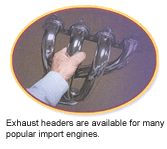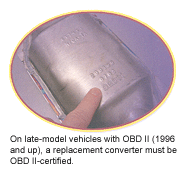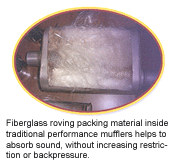High-performance mufflers and exhaust systems are as much about looks and sound as they are about horsepower. Most customers who want these types of products want mufflers and exhaust systems that look and sound as good as they perform. It’s all about personalizing their vehicle and projecting an image. Customers who buy performance exhaust products are the same ones who buy aftermarket custom wheels, street performance tires, performance shocks, struts and suspension kits, aftermarket sound systems, spoilers, wings, aero kits and other bolt-on accessories.
Polished stainless-steel mufflers and free-flowing cat-back exhaust systems are hot bolt-on upgrade opportunities, and can be easily installed on most import sport compact cars and larger cars, SUVs and trucks. The most popular applications for these kinds of upgrades are the sporty cars that teens, twentysomethings and even some over 30 are driving, such as the Honda Civic, Accord and Prelude; Acura Integra and RSX; Mitsubishi Eclipse and Lancer; Mazda Miata, MX-6, Mazda6, RX-7 and RX-8; Nissan 300ZX and 350Z; Toyota Celica, Matrix and Scion; Subaru WRX; and VW GTI, Golf, Passat and Beetle.
Of course, the market for performance exhaust products certainly isn’t limited to only these vehicles. Anybody who drives almost any import make or model could be a prospect for an exhaust upgrade if they are looking for more power or want to customize the appearance of their vehicle. You probably won’t run into many luxury car or SUV owners who fit this category, but you never know.
CASHING IN
Unlike your typical customer who may gripe about spending money on maintenance and repairs, these people actually enjoy spending money to accessorize, customize and improve their vehicles. It’s a high-priority item, and they spend accordingly. It’s not a hard sell.
There’s a huge market opportunity for shops who want to pursue this market. Why? Because the performance exhaust market has been steadily growing for years, while the ex
haust replacement market has been flat and trending downward. According to the Specialty Equipment Market Association (SEMA), about 23% of performance exhaust products are sold direct to vehicle owners via mail order or the Internet. Most of these products are installed by the vehicle owners themselves. Even so, do-it-yourselfers often run into installation snags, and the vehicle owner ends up needing some professional help to finish the job.
What makes this such a hot opportunity for you is that you often have first crack at selling your customer exhaust replacement parts. If you regularly service a customer’s vehicle – and take the time to inspect the exhaust system for possible problems – you’ll often discover pipes and mufflers that have reached the end of the road or will soon need to be replaced. Bring it to your customers’ attention and offer them some repair alternatives so they can decide what to do. Offering some upgrade options, such as installing a stainless-steel system that won’t rot out in a few years, may not only get you their business, but a more profitable repair as well.
Better yet, don’t wait for pipes and mufflers to fail. Go after the sport compact street performance customer who may be itching to upgrade his exhaust system but can’t do it himself. Offer such customers your expertise and installation service to make it as easy as possible – and charge accordingly.
STAINLESS EXHAUST
Most premium-quality performance mufflers and pipes today are made of stainless steel (usually aircraft-quality T-304), but there are lesser quality grades of stainless that sell for less. Aluminized steel is another option, but it doesn’t have the durability of stainless. Even so, aluminized steel is much better than plain, uncoated or painted steel.
 Most performance pipes are formed with mandrel bends which do not narrow the diameter of the pipe where it curves. This reduces unwanted restrictions and keeps the exhaust flowing freely. Most premium mufflers and systems are also plasma or TIG welded to maintain the strength and corrosion resistance of the stainless steel. Some manufacturers also use a process called “bulge forming” or “hydroforming” to form steel sheets into molded shapes using extremely high fluid pressure.
Most performance pipes are formed with mandrel bends which do not narrow the diameter of the pipe where it curves. This reduces unwanted restrictions and keeps the exhaust flowing freely. Most premium mufflers and systems are also plasma or TIG welded to maintain the strength and corrosion resistance of the stainless steel. Some manufacturers also use a process called “bulge forming” or “hydroforming” to form steel sheets into molded shapes using extremely high fluid pressure.
DIRECT FIT OR UNIVERSAL?
Performance mufflers are available in both direct-fit or universal configurations. You’ll find the greatest selection in universal products, which can be adapted and made to fit almost any vehicle. But the main drawback of one-size-fits-all mufflers is that they sometimes require cutting and welding pipes, and fabricating hangers and mounts.
When the stock muffler is removed, the existing pipe may have to be cut, shortened or lengthened. If the pipes are getting weak, they may also have to be replaced to complete the installation. New hangers are often necessary to support the muffler, or existing hangers may have to be repositioned to provide proper support and keep the system from flexing or rattling. Clearance may be another issue, especially with large oversized muffler cans that are not the same size, shape or length as the original muffler.
Most of these modifications are not difficult or expensive to make, but they do take time, so be sure to take that into account when pricing the job.
Making modifications to a stock exhaust system raises another issue. It may complicate matters if the customer ever wants to go back to a stock muffler. This may not seem like much of an issue when a customer is paying to have a custom muffler installed. But eventually, all vehicles are sold or traded and, at that point, the vehicle’s owner may want to keep his high-dollar stainless steel muffler for his next vehicle. Or, the vehicle’s next owner may want to go back to a stock-type muffler. So the fewer modifications that have to be made to install a custom universal-fit muffler, the better.
Direct-fit mufflers usually don’t require modifications or changes because they are designed to replace the stock muffler perfectly. Most are a simple bolt-in installation that connect to existing pipes and have mounts that line up with the stock hangers. The major drawback with direct-fit custom mufflers is limited availability for less popular models.
Sound quality is something that’s harder to control with universal-fit mufflers than direct-fit mufflers, which have been engineered for a specific vehicle application. Different engines sound differently and produce different frequencies and harmonics in their exhaust systems. So don’t expect a universal muffler to sound exactly the same, regardless of what kind of vehicle it’s installed on. It won’t.
At the same time, some performance mufflers are tunable in that they have removable baffles. The driver can change the sound by adjusting or removing the baffles.
COMPLETE SYSTEMS
Cat-back exhaust systems also are available in kits and are usually direct fit for easy installation. Pipes may be stainless steel, aluminized steel or plain steel and will be priced accordingly. Pipes may also be larger than the stock pipes to reduce backpressure and increase flow.
 How much power a performance muffler and exhaust system will add to an engine depends on a lot of variables. A more restrictive stock system and more free-flowing replacement system equals a better gain in horsepower.
How much power a performance muffler and exhaust system will add to an engine depends on a lot of variables. A more restrictive stock system and more free-flowing replacement system equals a better gain in horsepower.
Most manufacturers claim power gains of 15 to 25 horsepower or more with their products. The larger the displacement of the engine, the more it usually benefits from upgrading to a free-flowing exhaust system. This is especially true with turbocharged engines. Reducing exhaust backpressure allows boost to come up more quickly and to reach a higher level. Throttle response is improved and the engine runs cooler and stronger.
One thing to keep in mind when installing a performance exhaust system is heat management. Exhaust systems reflect a lot of heat. That’s why stock systems often have heat shields to keep heat away from the floor, fuel tank, brake lines and fuel lines. So reuse or fabricate heat shields where necessary to keep heat away from anything that might be heat-sensitive.
HEADERS
Exhaust headers also are available for many popular import engines. The free-flowing four-into-one or four-into-two-into-one welded tube headers are more efficient at routing exhaust out of the engine than the stock manifolds, and provide a boost in both power and torque for a couple hundred bucks.
Stainless-steel headers are the most durable, and the most expensive. Plain steel headers that have been coated with ceramic/metallic compounds will also retain their appearance and remain rust-free on street-driven vehicles much longer than plain steel-painted headers. Thermal coatings also help to retain heat in the pipes, which reduces underhood temperatures and increases exhaust velocity for better throttle response. They look good, too. Installing exhaust headers may be easy or difficult depending on accessibility and the age of the vehicle. Just make sure the headers have the required fittings for the oxygen sensor or other emission hookups that are required to be street legal.
When installing headers, don’t use stock exhaust manifold gaskets. Use a premium type of gasket made of graphite or multi-layer steel (MLS). There is a tremendous amount of heat and motion between the cylinder head and headers, so use gaskets that can withstand both. On older vehicles that have a carburetor, changing the headers and exhaust system may require rejetting the carburetor to maintain the proper air/fuel ratio. This shouldn’t be necessary on fuel-injected engines with O2 sensors because the engine management system should compensate for changes in exhaust flow. Just make sure there are no air leaks between the cylinder head and headers that might confuse the O2 sensor.
STREET LEGAL?
Some companies make complete exhaust systems that run from the engine all the way back to the tailpipe, but eliminate the catalytic converter. These are great for racing but are not street-legal systems unless a vehicle is exempt due to its age (typically older pre-converter-equipped vehicles).
Low-restriction aftermarket performance converters are available and can be installed in place of the original converter if the OEM converter is out of warranty or has failed an emissions test. But the converter must meet the applicable EPA requirements to be street legal. On late-model vehicles with OBD II (1996 and up), a replacement converter must be OBD II-certified.
 Noise is the other concern with some aftermarket performance mufflers and exhaust systems. Reducing backpressure with a straight-through muffler often allows more decibels to blow out of the tailpipe unabated. High-revving four-cylinder engines typically produce a high-pitched buzzsaw sound. A properly tuned system will dampen the higher frequencies and allow a lower, more powerful tone to emerge. Others seem to pass every exhaust pulse unabated, resulting in an ear-splitting racket that sounds like an open exhaust.
Noise is the other concern with some aftermarket performance mufflers and exhaust systems. Reducing backpressure with a straight-through muffler often allows more decibels to blow out of the tailpipe unabated. High-revving four-cylinder engines typically produce a high-pitched buzzsaw sound. A properly tuned system will dampen the higher frequencies and allow a lower, more powerful tone to emerge. Others seem to pass every exhaust pulse unabated, resulting in an ear-splitting racket that sounds like an open exhaust.
Many owners of street performance vehicles love the sound of a powerful exhaust system. But others may find the noise to be annoying. Many communities have sound regulations and will ticket a vehicle owner if their exhaust is deemed to be excessively loud. But such rules are typically enforced at the discretion of the local law enforcement officers who may or may not make it an issue depending on the driver’s driving habits and previous encounters with the law.

